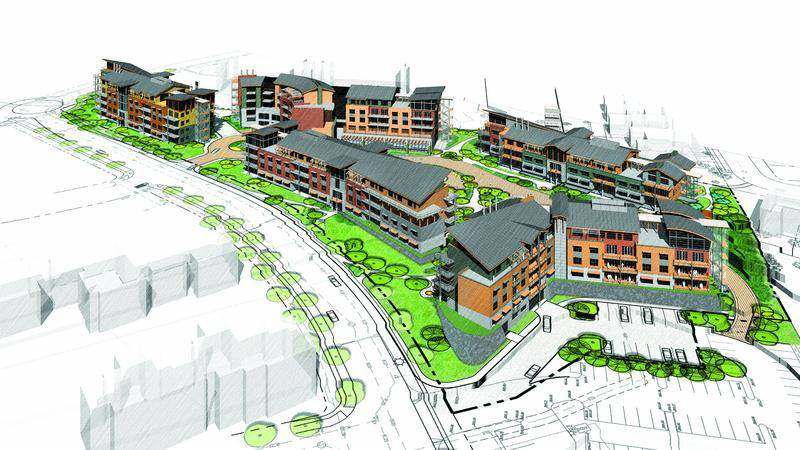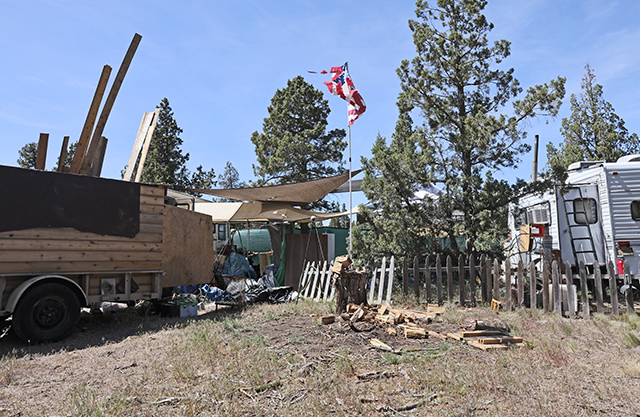Village to add new twist to Bend real estate
Published 5:00 am Sunday, August 20, 2006

- The Village hotel/condominium project is proposed to include five buildings on the edge of the Old Mill District. The project, estimated to cost at least $127 million and be completed in two to three years, calls for 199 hotel room/condo units comprising 297,000 square feet of housing space. The project also calls for 25,829 square feet of spa and restaurant space.
The developers who want to build a huge new hotel/condominium project on the bluffs above Bend’s Old Mill District say they don’t just want to join the Bend real estate market.
They want to add a whole new layer to it.
”This definitely will be something that will break into a new market in Bend,” Inland Pacific Cos. lead developer Timothy O’Byrne said last week. ”This is definitely in the league and class of Pronghorn. Maybe Sunriver.”
The project, dubbed The Village, would put five buildings on the site of the old Brooks-Scanlon executive offices building at 500 S.W. Bond St., near the busy intersection of Wilson Avenue and Bond Street and up the hill a bit from the Old Mill District’s existing rooftops.
Initial plans, filed with the city earlier this month, call for five buildings that will range from the tallest, at five stories and 72 feet, to the shortest, a two-story, 40-footer near the back of the 5.9-acre site.
The buildings will hold up to 199 hotel room/condo units, along with a spa and wellness center, and a restaurant and bar. They will wind around a landscaping scheme the developers and their Colorado architects, Oz Architecture, refer to as ”European-style courtyards,” with walking paths that will link the buildings and link the neighborhoods behind the complex to the Old Mill District across Bond Street.
Almost all of the parking will be underground, which will allow the developers to confine built-up space to about 30 percent of the site.
The rest, O’Byrne said, will be devoted to trees, ponds, walkways and landscaping.
The complex’s size alone is imposing. Plans call for more than 297,000 square feet of housing units, along with 25,829 square feet of spa and restaurant space – more than half again as large as The Mercato, a retail, office and condominium project that recently gained city approval to go up on the other end of the Old Mill District.
The cost is also staggering – O’Byrne estimates it at around $127 million in today’s dollars.
Once the project is complete, though – O’Byrne estimates completion in two to three years – it could add an entirely new layer to the city’s already diversified real estate mix, bringing an upscale destination resort within city limits that is designed to appeal to a mix of vacationers, second-home buyers and pure investors.
Hotel/condos are new to Central Oregon, but they are a familiar concept in the vacation hot spots of California and Florida and in major cities across the country.
In concept, investors will buy their own units and pay fees to cover the cost of running the complex, as with any condominium, O’Byrne said. But the complex will be designed to operate as a four-star or better hotel, complete with on-site room service, a concierge, a front desk, and full laundry and maid service.
Owners will be able to stay in their units indefinitely or rent them to nightly guests through the complex’s rental pool.
Based on today’s market conditions, O’Byrne said he would expect the complex’s lower-range rooms to start at $200,000 to $300,000, with top-end penthouses ranging up to $2 million.
Nightly rentals would range from $160 to $170 for base studio units and up to $500 a night or more for penthouses.
Unit owners will likely share the nightly rent on a 50-50 basis with the hotel operator who ends up running the complex, O’Byrne said. The developers, New500Bond LLC, have contacted a variety of hotel management companies, O’Byrne said, but no deals will be done until the project is further along.
For the sellers, hotel/condo concepts carry a couple of distinct advantages, said O’Byrne, whose company has led the development of a Westin hotel/condo project in its home base, Westminster, Colo., along with projects in south Florida and Southern California.
They provide a cash infusion up front from the sale of condo units and allow the developers to tap into the large nationwide pool of small individual investors rather than having to find a single big buyer.
They also give the development a chance to float on the possible relative strengths of two different markets, O’Byrne noted: If the condo market collapses, the project has a hotel component to distinguish it. And if the hotel market cools, the sellers can try to tap the second-home market for condos.
Hotel/condo projects tend to appeal to a different mix of buyers, depending on where they are located, O’Byrne said. In Bend, Inland Pacific expects the main market to come from second-home buyers from Seattle, Portland and California who want a place to stay for a week or so out of every month, with the possibility of generating a rental stream in the off times.
For buyers, the advantages include owning hassle-free property, as with most condos – with the added benefit of having a ready rental market for the unit when they are gone, with hotel amenities while they stay.
The project is flying into the face of a second-home market that is cooling nationwide.
Nationwide statistics haven’t been gathered on the second-home market since 2004, but in one of the nation’s hottest second-home markets, Naples, Fla., median prices in June fell 8 percent from the year before as sellers flooded the market with inventory, the New York Times reported last week.
In Ocean City, N.J., where 73 percent of the housing stock is owned by people who own homes elsewhere, prices rose nearly twice the national average through 2005 as the national market for second homes boomed, according to the Times. But prices there have pulled back by 10 percent to 15 percent from a year earlier as inventories have swelled.
Despite that, O’Byrne said he’s not concerned about the health of the Bend market in the long term, particularly for a project that has no local competition.
Bend’s mix of winter and summer sports, combined with prevalent sunshine and its proximity to the California and Northwest urban markets, makes it ”one of the most amazingly located pieces of real estate in the world,” O’Byrne said. But, up to now, it has lacked a high-end resort draw within its city limits.
The backers behind The Village were particularly encouraged by two relatively recent developments, O’Byrne said: The start of daily direct flights to Los Angeles and weekly direct summertime flights to Denver, tapping into two huge Western markets, along with the success of Pronghorn, an upscale development east of town that has proven Central Oregon can draw big-money investors to resorts that are not located in Sunriver.
”Bend is such a destination, in and of itself, that we should call this a destination within a destination,” O’Byrne said.
The project will need approvals from the city to exceed the Old Mill area’s 35-foot height limits before it can move forward. It also will need approval to locate a hotel in the Bond Street area that was originally set aside for high-tech offices and industrial sites in the Old Mill’s original master plan.






